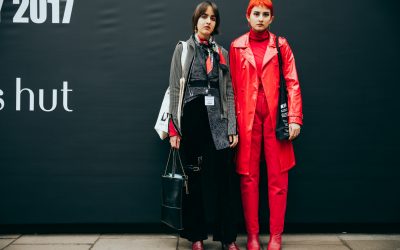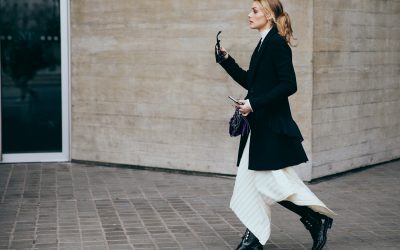Online shopping is still full of glitches, but a bright new tech-powered future is closer than you think
Words Tatjana Apukhtina
It’s a truism to say that technology is transforming the way we shop. Technology isn’t transforming the way we shop. It is the way we shop. It’s no longer disrupting our habits; it’s trying to keep up with our demands.
We might still hold onto some quaint image of lazy browsing round local boutiques, and that may still translate into reality on the odd weekend, but it’s a long time since such a romantic vision of shopping was our everyday default. In 2017, we want to buy the best products at the lowest price and spend the least possible effort to find them. We are slaves to convenience and speed, and online retailers like ASOS are cashing in while the petrified high street desperately tries to figure out how to combat the ever-decreasing footfall.

We’re a tough crowd, and the brutal reality is that online, we have a bigger selection and better price transparency, not to mention the ability to shop from the comfort of our sofa – or, more likely, from the discomfort of a bus, stabbing the buy-now button on our phone after a rubbish Monday at work.
The solutions to most of these problems already exist. The problem is businesses’ ability or willingness to change complex production, distribution, purchasing and customer relationship management systems to fit it in.
But although it has become our default, the online clothes-shopping experience is still very far from perfect – in fact, sometimes is barely functional. The simple fact is that clothes always look better on models in images than they do on me in real life, and every other package that comes to my door seems to feature an item that’s the wrong size, the wrong shade (cool off-pink in the picture, 1970s salmon on my shoulders) or a terrible fit. It seems incredible that many retailers still charge for returns, and most necessitate a schlep to either a post office (I’m sure there are fewer of those around these days) or a supposedly convenient but actually miles-away pick-up point.
The interesting thing is that the solutions to most of these problems already exist. As is so often the case, the technology there; the problem is businesses’ ability or willingness to change complex production, distribution, purchasing and customer relationship management systems to fit it in. However, it really is only a matter of time before online retailers implement these new tools on a mass scale. They won’t survive if they don’t.

So what tech will we see rolled out into the mainstream in the next ten years?
Drones are a safe bet. It’s very likely that these ‘unmanned aerial vehicles’ will deliver most of our parcels by 2027 – they’re cheaper, faster and more convenient, and they’ll also be able to collect them, solving the returns rigmarole.
Then there’s the next gen of mirrors. I predict that every household will have at least one “magic mirror” proudly hanging on their bedroom wall. With the help of augmented reality we’ll be able to turn our homes into sci-fi digital shopping malls. Imagine browsing through an online store at home, then checking how your chosen hero item looks in the mirror before placing an order. Voice recognition technology will come into play here; think Amazon’s ALEXA, but for fashion. Say the word (literally), and pre-uploaded images of your wardrobe favourites, as well as just-in items from your favourite stores, will mix and match before your eyes.

One example already on the market is produced by a company called FXMirror: a 3D virtual fitting room solution for shops that allows customers to change in and out of clothes with a tap of their fingers. But you can also have your very own Sleeping Beauty moment right now, in the comfort of your own bedroom. Check out the YouTube video below to find out exactly how to create your own Rasperri Pi Smart Mirror, DIY style.
Of course, the elephant in the room here is: if shopping online will become so fun, functional and frictionless, will brick and mortar stores even exist?
For the next ten years, yes, certainly. Most likely for at least the next 50, in fact. Because while online shopping is on a rise, it still represents only around 15% of the total sales for the most heavyweight high street retailers. However, due to the staggering growth rate of digital retail, physical shops need to start playing all their best innovation cards in order to survive.
Key to success will be the ability to achieve a seamless merge between the digital and physical. The best example to date is Burberry’s London flagship store. The proudly British brand is a mastermind when it comes to digital in-store shopping experiences, from interactive ads to smart ordering and CRM. Other big-name retailers can’t be far behind.
Other demands that digitally-spoilt customers will bring to physical stores include shorter queues at checkouts, AI shopping assistants for a personalised styling experience, in-store entertainment with help of augmented reality, and same-day home delivery (who wants to walk around the high street any more with heavy shopping bags?).
A zero-queue world is getting closer thanks the new “Amazon Go” concept store. All you have to do is check in with your phone as you enter, then you’re free to pick up whatever you want and just walk out of the store. The payment is automatically deducted from your account.
With the help of augmented reality we’ll be able to turn our homes into sci-fi digital shopping malls
Now take this idea and remove the mobile phone – because checking in with your phone will be waaaaaay too much effort in 2027. It’s more likely that your face will be automatically recognised as you walk into the store? Biometric technology is getting some big investment right now – you might have noticed the rising popularity of e-gates at airport passport controls.
If you’re getting worried at this point about losing control of your personal data, you’d better suck it up. I really do think that anonymity will be impossible over the next 10 years – if, that is, you want to remain in the mainstream consumer economy. The internet of things is coming to get you. The internet will soon be plugged not just into your devices but your clothes, your house and, according to Elon Musk, even your brain.
Yep, it can feel pretty scary. But convenience comes at a cost.
Another piece of technology that will shape the future of shopping is the rise of personalized services with the help of smart algorithms and AI learning. In a way, you’re already experiencing this whenever you shop on Amazon, which learns about your preferences by analysing your shopping history and gives you recommendations for new products every time you log in.
At my own startup, Looks Good On Me we’re developing a virtual stylist to assist you in finding the right items to suit your size, style and needs. Imagine shopping with someone who knows exactly which clothes will work best with your body shape, which colours will complement your complexion and which items you’re still missing from your wardrobe for that upcoming trip to Florence. Only that this someone is not a person – it’s an app, a virtual AI fashion PA.
Last but not least, we’ll see the rise of bricks and mortar shopping as an entertainment activity. Online will always win out for ease and speed, but I can’t see us letting go of the social and aesthetic pleasures of a high street stroll any time soon. So, whether they opt for something as simple as an in-store music stage or as digitally advanced as an immersive multimedia augmented reality experience, we’ll see retailers coming up with more and cleverer ways to entertain the shopping crowd to ensure footfall into their stores.
Shopping, 2027-style: it’s closer than you think.
Tatjana Apukhtina is the Co-Founder of Looks Good On Me and blogs at FashionArtista.com
Related reading…
Meet K Á R Y Y N, the LA-based musician with a love song for Aleppo
The musician opens up about Syria, spirituality and using anger in a positive way
Meet the Most Stylish Show-Goers from Day 4 of London Fashion Week AW17
From bloggers to Editors-in-Chief, we round up the best of the street style contingent
Meet the Most Stylish Show-Goers from Day 3 of London Fashion Week AW17
From bloggers to Editors-in-Chief, we round up the best of the street style contingent



